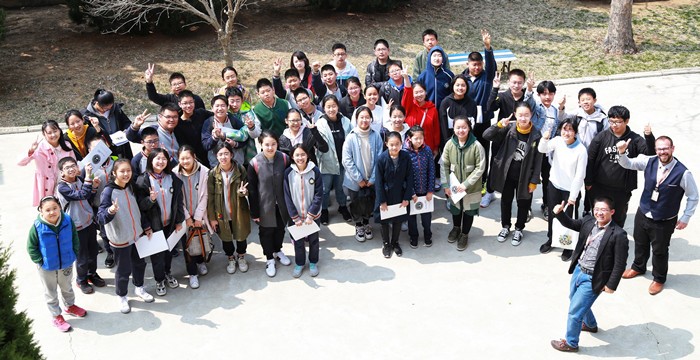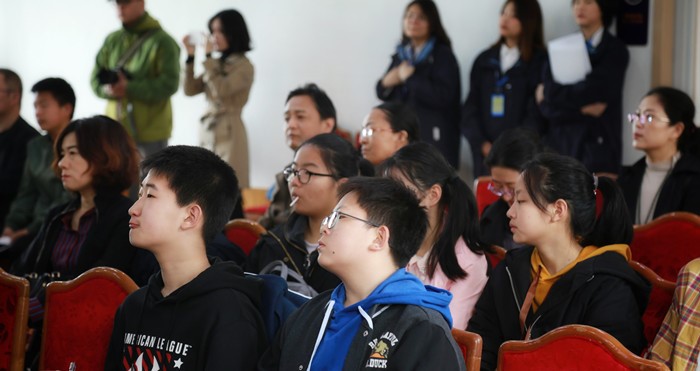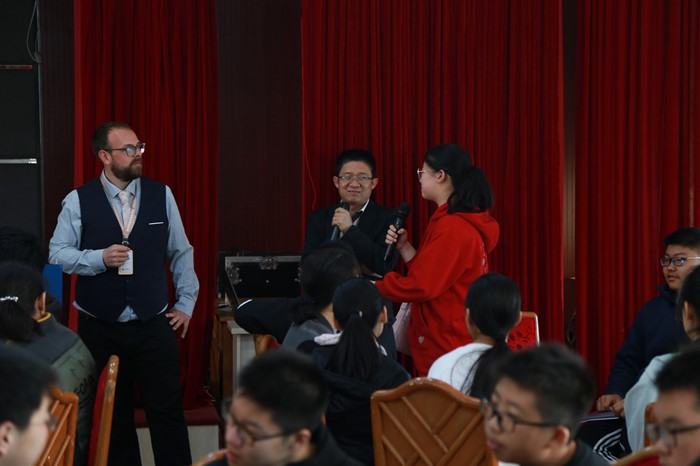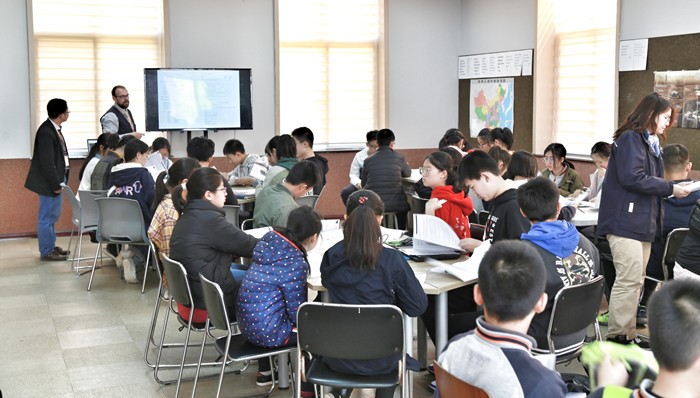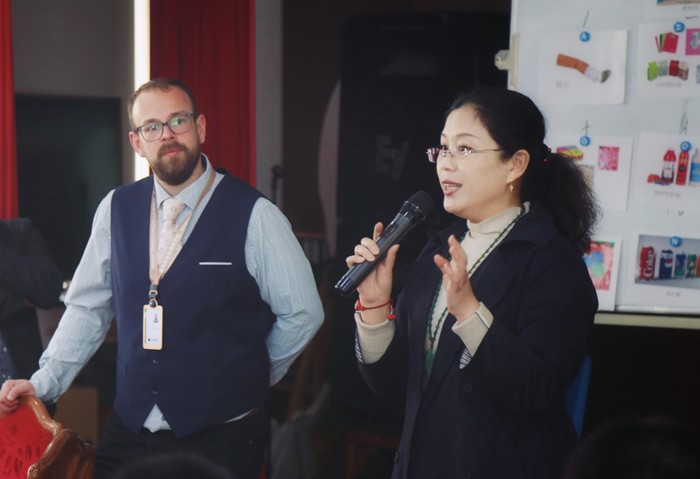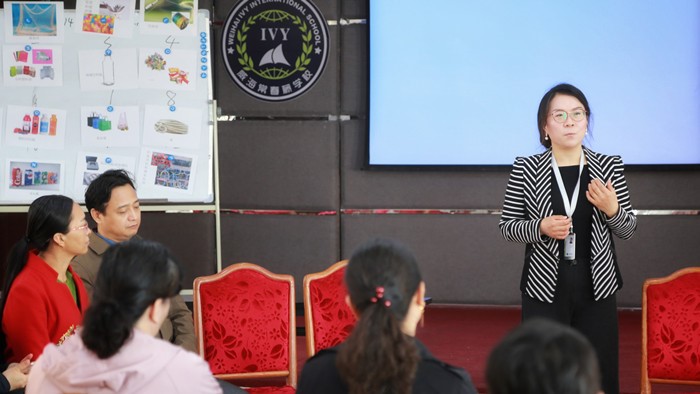|
Latest News
|
The meeting of Ivy Marine Conservation Group ended successfully.On April 13, the Ivy League International School successfully concluded its public welfare activity of "Protecting the Blue Sea and Protecting the Finless Porpoise". More than 50 students from Weihai Experimental Middle School, Huancui International Middle School, Guzhai Middle School and Tashan Middle School participated in the event. John, the academic principal and project sponsor of our school, explained in detail the content and significance of the study public welfare activities for the children who came to participate in the event. The children are also full of expectations for this marine conservation project, and have expressed their desire to do what they can for the protection of marine life.
That morning, the sun was warm and the spring wind was intoxicating. Around 8:30, students from Weihai middle schools came into the Ivy League campus one after another in groups. Their eyes were filled with curiosity, expectation and excitement. Many students have done a lot of homework for this marine protection activity in the early stage. Some students also participated in the marine anatomy activity organized by Ivy League last year. They are bound to win this "marine environmental protection war". The first thing I did when I came to Ivy League was to fill out the application form for volunteers to "Protect the Blue Sea and the Finless Porpoise". Under the guidance of Mr. Derek, the team members were divided into nine groups and set up volunteer files for each group. From today on, you are the official members of the Marine Protection Team. In order to make the ocean more beautiful, let's fight together.
Student Harvest: Ivy and China Blue Ribbon Marine Conservation Association jointly organize this activity. Students will join the Marine Environmental Protection Group as part of the Blue Ribbon Marine Conservation Activities. Public welfare, practical and positive energy activities will enable children to reap rich harvest. Deeply Understanding Marine Environmental Pollution At 9:00 a.m., project sponsor, Ivy League academic principal and biology teacher John introduced the environmental protection project of "Protecting Blue Sea and Finless Porpoise" in detail for the children. Ivy Teacher and Blue Ribbon Marine Conservation Association member Paul translated. The project consists of six parts: collecting information, designing surveys, assessing biodiversity, understanding the local marine economy, participating in beach cleaning and displaying research results. This challenging and practical project plan is of great interest to all of you.
How serious is marine pollution? It's probably more serious than you think. Inside the calm sea, countless marine creatures suffer misfortune because of human casual actions over and over again. Experts predict that the number of plastic in the sea will exceed that of marine life in 2040, which makes people think deeply. Plastics are not only harmful to the environment, but also harmful to human health. The first phase of the project is mainly about plastic, one of the main culprits of marine pollution. At this stage, students will conduct online research, collect information, and outline relevant issues of global and local plastic epidemics. Everyone will record the plastic products used in their homes every day for a week, starting from the side, to form the first-hand data about plastic. This is also your first assignment after joining the environmental protection group.
Student Harvest: Starting from the dribs and drabs of life, it is helpful for children to understand the universality of garbage pollution, and it is also easier to record and research. The next six stages of research practice enable children to enhance their comprehensive ability from multiple perspectives, including critical ability, practical ability, cooperative ability, logical thinking ability, problem solving ability and so on. Design research papers by yourself In order to let you better understand the types and pollution of marine garbage, our teacher set up an interesting game for you. Pictures sent to children are everyday garbage, but do you know which kind of garbage is found more in the ocean? Most children choose plastic bags, but the correct answer is cigarette butts!
How to write academic papers correctly and express the previous investigation accurately in words is related to the professional paper writing norms. President John of our university explained the paper writing norms for everyone, including document citation, format norms and so on. At the same time, the paper rating standards were stipulated. When you have written the first draft of the research report, our teacher will revise it for you.
Student Harvest: Cultivating research thinking should be done as soon as possible. Writing papers is not the patent of highly educated students. When you investigate bit by bit, gather a group of data, and then summarize them to form your own fruitful works, it will be a very successful thing! In this process, children's thinking ability and practical ability are well exercised. Parents Share: A "Beast" Seeking Help from People Marine pollution is shocking and parents should share their stories. A parent at the scene shared a very legendary event for you. When his elders went to sea by boat at night, they met a "sea monster" calling for help. When the crew approached, they found that its mouth was full of trash such as fishing nets and plastic. The people on board helped him out, but because it was dark, they couldn't see exactly what animal it was.
Establishing Green Family View While students learn about marine environmental protection, Anny Wang, a senior family education teacher, shares a new concept of family education, green family, with the theme of environmental protection. Green family concept refers to the creation of a natural, harmonious, scientific and caring family atmosphere. The pun of "green family" refers not only to the greening of family environment, but also to the harmonious coexistence of families. A healthy and pollution-free family is essential for the growth of children. Anny calls on the family to cultivate the concept of green life, cherish resources, protect the environment, create a green atmosphere, make the family full of color, and let children develop good habits of environmental protection from an early age. At the same time, we should create a healthy family education environment, pay attention to the cultivation of children's moral level, and create a family atmosphere of mutual respect and harmonious care. Parents should often look at themselves, establish the concept of lifelong learning, and have an equal dialogue with their children, so as to set a good example for their children.
A meaningful public welfare activity of oceanographic research has brought great benefits to children. If ocean pollution continues to deteriorate, the blue and clear water, the colorful fish in the sea, the free-play porpoise and so on will become memories like the bell tower of Cassimodo. In order to stop the tragedy from happening again, we should do what we can for the beautiful ocean. Protecting the oceans and marine life, we still have a lot to do next, let's work together!
|

